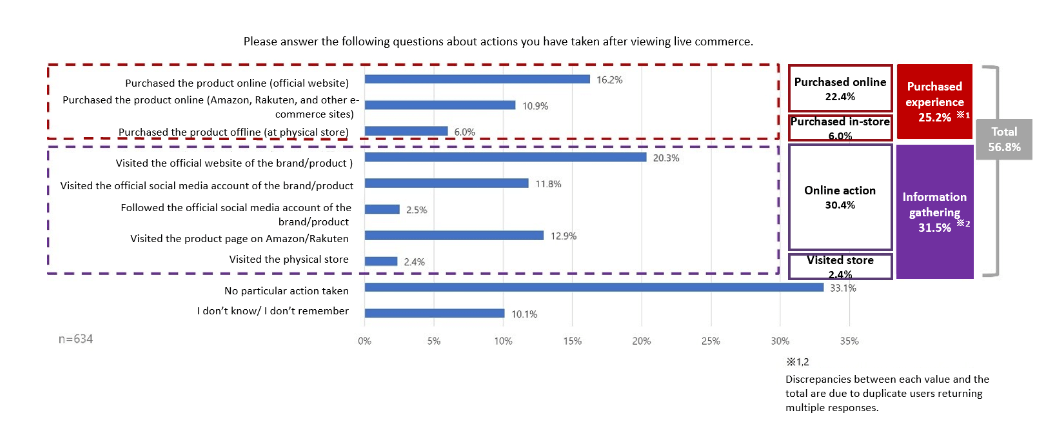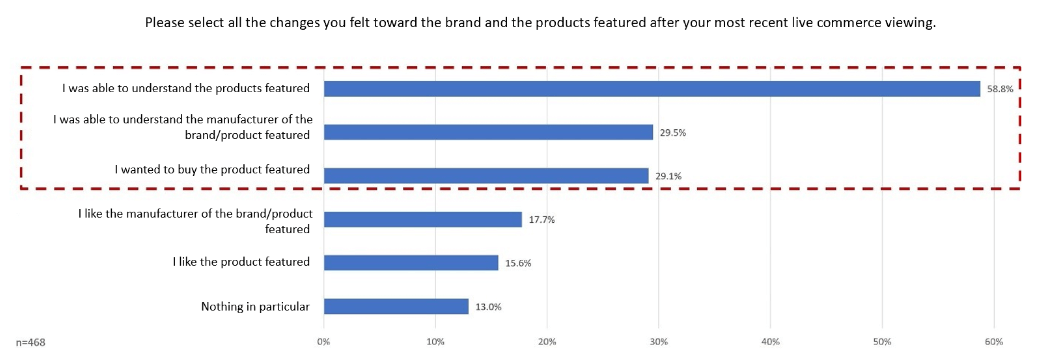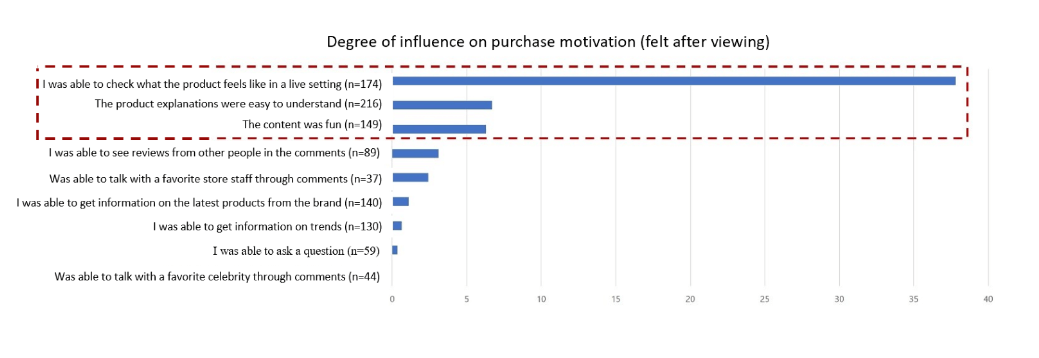Based on the results of a survey conducted to understand the live commerce audience, we analyzed live commerce’s effects on attitude changes and the factors that influence attitude change. This section presents the results of that analysis and discussion, as well as findings closer to the heart of the matter regarding the medium- and long-term effects of live commerce. In the first part of this report, we presented the survey results in detail.
1. User survey background
Live commerce has advantages over other measures because of the highly live and interactive nature that is achieved through online streaming.
While there are many advantages, the bottleneck that prevents clients from implementing it is cost-effectiveness. Properly implementing live commerce will still cost money, and if sales are not expected to recover that cost, it’s only natural that companies will hesitate to implement it. However, this is a concern because you are considering live commerce as a measure with short-term sales as the KPI, but it’s a different story if you’re considering it as a measure with medium- to long-term effects. The mid- to long-term effect is that the viewing experience during live commerce and the promotion of product explanations and brand understanding will encourage viewers to purchase products and continue purchasing when viewed over a longer time frame.
Some viewers may think of live commerce as an information-gathering opportunity to see how a product feels and looks, and then decide to purchase it later when they see it in person at a physical store. Looking at the short-term sales effect of live commerce on an e-commerce site misses these later sales in the physical store. Also, if live commerce is making existing customers become fans and loyal to your brand, the figures you should be looking at are the repeat rate, customer loyalty, and LTV. If live commerce is conducted frequently enough to make existing customers loyal, it’s possible that at some point, sales will increase as a result of live commerce.
In other words, when evaluating live commerce as a measure, setting short-term sales as a KPI will lead to underestimating its effectiveness and value. This concept can only be substantiated when it is confirmed that the viewers’ understanding and liking of the brand have increased due to the change in attitude caused by live commerce. However, the presence or absence of such attitudinal changes is qualitative and difficult to ascertain this through measurement tools.
This article identifies the attitude changing effects of live commerce and the factors that influence attitude change and presents findings that are closer to the core of the medium- to long-term effects.
2. What are the effects of live commerce? Behavioral changes and effects on attitude
2.1 Behavioral experiences of live commerce viewers
First, to elucidate the effects of live commerce, we surveyed what people felt after watching live commerce. Looking at the actions that live commerce viewers took after watching, the percentage of users who experienced some kind of purchase was 25.2%. The percentage of users who took some kind of action related to gathering information was 31.5%. Together, 56.8% of users took some kind of action after watching live commerce (Figure 1).

When looking at the timing of purchases after viewing live commerce, the purchase rate was higher within three days of viewing than during or immediately after viewing (Figure 2). Furthermore, live commerce not only has an on-the-spot sales promotion effect, but also has a residual effect on at least 17% of users up to one week later. These results indicate that live commerce is not only effective in the short term but can also be expected to have some residual effect.

2.2 Attitude changes of live commerce viewers
Next, we’ll look at the effects on attitude changes. Figure 3 shows the results of attitude change after viewing live commerce. The results of the survey show that about 90% of the respondents had some kind of attitude change (understood the product or brand, wanted to buy it, or liked it) after watching the live commerce.

Looking specifically at the results, we can see an improvement in the understanding of products and brands in particular (Figure 4).

These results indicate that live commerce is expected to have not only short-term effects but also behavioral change effects, including residual effects, as well as attitude changing effects such as an understanding and liking of the featured products and brands.
The reasons for these results include:
- Two-way communication makes it easier to provide information that viewers seek.
- When the performer actually uses the product, it is easy to convey the feeling of using the product.
- Introductions by staff and celebrities of favorite brands are more likely to be persuasive.
3. Enhancing the effects of attitude change: configuring content based on attitude
The survey results in the previous section indicate that live commerce is a measure that can also be expected to have an effect on attitude change. So, how can live commerce that generates more attitude changes be created? In this section, we’ll break down the content features of live commerce shows and analyze the most effective features for each attitudinal change you wish to target.
※Method of analysis used in this study: Logistic regression analysis
When the objective variable is split into two values, the probability of which of the objective variables will be the case from the values of the explanatory variables is obtained using this method. This time, we focused on the influence of each explanatory variable on the determination of the value of the objective variable, which is detected in the calculation process, and analyzed the factors that cause attitude change in live commerce.
3.1 What content features increase brand favorability?
Analysis of what people felt increased brand favorability after watching live commerce showed that having a conversation was the most influential factor in increasing brand favorability. Other factors such as the explanation of the products being easy to understand and learning about the brand’s newest drops also had an impact (Figure 5). In other words, feeling a sense of specialness and the live nature of obtaining information through conversations in order to increase brand favorability were found to be crucial factors.

3.2 What content features increase product understanding?
When analyzing the perceptions of those whose product understanding increased after viewing live commerce, the impact of explanations being easy to understand was by far the most significant (Figure 6). In other words, while live communication is required to increase brand favorability, the ease of understanding explanations from store staff is becoming more important in terms of increasing product understanding.

3.3 What content features increase purchase motivation?
When analyzing the perceptions of those whose understanding of the product increased after viewing live commerce, the most significant results were found in being able to check the appearance and feel of the products in a live setting and the ease of understanding the explanations (Figure 7). In other words, in order to increase purchase intention, it’s critical to convey the sense of use through live commerce, just like customer service in physical stores.

The results of this analysis indicate that the features emphasized differ depending on the attitude change one is aiming for. In other words, it’s possible to create live commerce that generates the intended attitudinal change and leads to purchases by planning with variable elements in the content.
4. Summary
The survey results indicate that live commerce can create value not only as a sales promotion aiming at short-term sales increase, but also as an advertising promotion and CRM measure to increase understanding and favorability of products and brands, and purchase intention of products. Considering that it contributes to more than just immediate and short-term sales figures, we suggest that you consider incorporating it into your marketing strategy based on medium- to long-term effects.
On the other hand, it’s difficult to start or continue live commerce in this difficult environment due to uncertain cost-effectiveness and still lack of distributors and distribution knowledge and techniques. Therefore, in order to make the developing live commerce strategy a more effective marketing strategy, communication and verification methods must be developed.
Irep Inc. provides total support from live commerce planning to verification design. We train specialists and perform everything from delivery optimization to verification using our casting business’s unique verification scheme.
We offer a variety of package solutions depending on the needs of the client company and the brand equity of the brand and product.
Want to know more about Live Commerce?
Contact us to discuss how we can work together.

Irep Inc. is an award-winning global digital marketing agency based in San Francisco Bay Area. Our headquarters are in Tokyo and our network spans more than 20 countries. In Japan, we are ranked No. 1 for performance-based marketing. We also offer highly specialized market entry, as well as integrated marketing and localization services. Since 1997, our data-driven solutions have effectively led our diverse international clientele to continuous success in Japan, Asia, and beyond.
Irep Inc.
LinkedIn: https://www.linkedin.com/company/irepinc
Email: info@irep.inc
Address: 900 Concar Dr. Suite 400, San Mateo, California 9440



